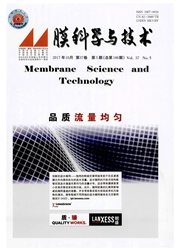

 中文摘要:
中文摘要:
渗透汽化是一种新型高效的膜分离技术,尤其在汽油深度脱硫技术方面具有独特优势.以PEI超滤膜为支撑层,PDMS为复合层,制备PDMS/PEI渗透汽化FCC汽油脱硫复合膜.通过傅立叶红外光谱仪(FTIR—ATR)对其进行了结构分析,考察了交联前后官能团的变化.通过扫描电子显微镜(SEM)分析了复合膜表面和断面的形态.在以前的工作基础上,将制备的PDMS/PEI复合膜应用于放大实验,在不同的料液体系中考察膜的渗透汽化性能.结果表明,对于正庚烷/噻吩体系,在80℃下连续操作28h,料液硫含量从200ng/μL降到10ng/μL,其平均通量为0.78kg/(m2·h),平均富硫因子为7.6.对于汽油加噻吩体系,平均渗透通量为0.06kg/(m2·h),平均富硫因子为4.8.该成果为膜法汽油脱硫深入研究和工业应用奠定了基础.
 英文摘要:
英文摘要:
Pervaporation is one of the most effective membrane separation technologies, especially with the significance and possibility for deep desulphurization of fluid catalytic cracking (FCC) gasoline. In this paper, crosslinked polydimethylsiloxane/polyetherimide(PDMS/PEI) composite membranes were prepared, in which asymmetric PEI membrane prepared with phase inversion method acted as the microporous supporting layer in the flat - plate composite membrane. The different function compositions of the PEG/PEI composite membranes were characterized by reflection FTIR. The surface and section of PDMS/PEI composite membranes were investigated by scanning electron microscope (SEM). Based on our previous studies, the composite membranes prepared in this work were employed in sacle - up process to investigate the pervaporation performance of the membranes in different feed conditions. During the operation of 28 h at 80 ℃ for n - heptane/thiophene mixtures, the feed total sulfur concentration decreased from 200 ng/μL to 10 ng/μL while average total flux and sulfur enrichment factor was 0.78 kg/(m2· h) and 7.6, respectively. Experiment results also demonstrated that the average total flux and sulfur enrichment factor for gasoline/thiophene mixtures was 0.06 kg/(m2· h) and 4.8, respectively. This work would be a foundational contribution to further investigation on gasoline desulfurization and practical industry application.
 同期刊论文项目
同期刊论文项目
 同项目期刊论文
同项目期刊论文
 Separation of Azeotropic Dimethylcar- -Bonate/Methanol Mixtures by Pervaporation: Sorption and Diffu
Separation of Azeotropic Dimethylcar- -Bonate/Methanol Mixtures by Pervaporation: Sorption and Diffu Hydrophobic Nano-silica/ Polydimethyl Siloxane Membrane for Dimethylcarbonate-Methanol Separation vi
Hydrophobic Nano-silica/ Polydimethyl Siloxane Membrane for Dimethylcarbonate-Methanol Separation vi Pervaporation Separation of Ethanol/Water Mixyures with Chlorosilane Modified Silicalite-1/PDMS Hybr
Pervaporation Separation of Ethanol/Water Mixyures with Chlorosilane Modified Silicalite-1/PDMS Hybr Waterborne Polyurethane/Poly(vinyl alcohol)Membranes:Preparation,Characterization,and Potential Appl
Waterborne Polyurethane/Poly(vinyl alcohol)Membranes:Preparation,Characterization,and Potential Appl Surface Modification of Polyvinylidene Fluoride (PVDF) Membranes by Low-Temperature Plasma with Graf
Surface Modification of Polyvinylidene Fluoride (PVDF) Membranes by Low-Temperature Plasma with Graf A Modified Solution-Diffusion Model and Its Application in the Pervaporation Separation of Benzene/C
A Modified Solution-Diffusion Model and Its Application in the Pervaporation Separation of Benzene/C Pervaporation Separation of N-heptane/organosulfur Mixtures with PDMS Membrane: Experimental and Mod
Pervaporation Separation of N-heptane/organosulfur Mixtures with PDMS Membrane: Experimental and Mod Pervaporation Properties of PDMS Membranes Cured with Different Cross-linking Reagents for Ethanol C
Pervaporation Properties of PDMS Membranes Cured with Different Cross-linking Reagents for Ethanol C Preparation and Pervaporation Performances of PEA-based Polyurethaneurea and Polyurethaneimide Membr
Preparation and Pervaporation Performances of PEA-based Polyurethaneurea and Polyurethaneimide Membr Pervaporation of Ethanol/Water Mixtures with High Flux by Zeolite-Filled PDMS/PVDF Composite Membran
Pervaporation of Ethanol/Water Mixtures with High Flux by Zeolite-Filled PDMS/PVDF Composite Membran Prediction Of Solubilities of Salts, Osmotic Coefficients And Vapor–Liquid Equilibria for Single and
Prediction Of Solubilities of Salts, Osmotic Coefficients And Vapor–Liquid Equilibria for Single and Separation of Ethanol from Ethanol/Water Mixtures by Pervaporation with Silicone Rubber Membranes:Ef
Separation of Ethanol from Ethanol/Water Mixtures by Pervaporation with Silicone Rubber Membranes:Ef Pervaporation Separation of Thiophene-Heptane Mixtures with Polydimethylsiloxane (PDMS) Membrane for
Pervaporation Separation of Thiophene-Heptane Mixtures with Polydimethylsiloxane (PDMS) Membrane for Separation of Propane From Propane/Nitrogen Mixtures Using PDMS Composite Membranes by Vapor Permeat
Separation of Propane From Propane/Nitrogen Mixtures Using PDMS Composite Membranes by Vapor Permeat A Modified Solution–Diffusion Model and Its Application in the Pervaporation Separation of Alkane/Th
A Modified Solution–Diffusion Model and Its Application in the Pervaporation Separation of Alkane/Th Separation of dimethyl carbonate/methanol mixtures by pervaporation with poly(acrylic acid)/poly (vi
Separation of dimethyl carbonate/methanol mixtures by pervaporation with poly(acrylic acid)/poly (vi 期刊信息
期刊信息
